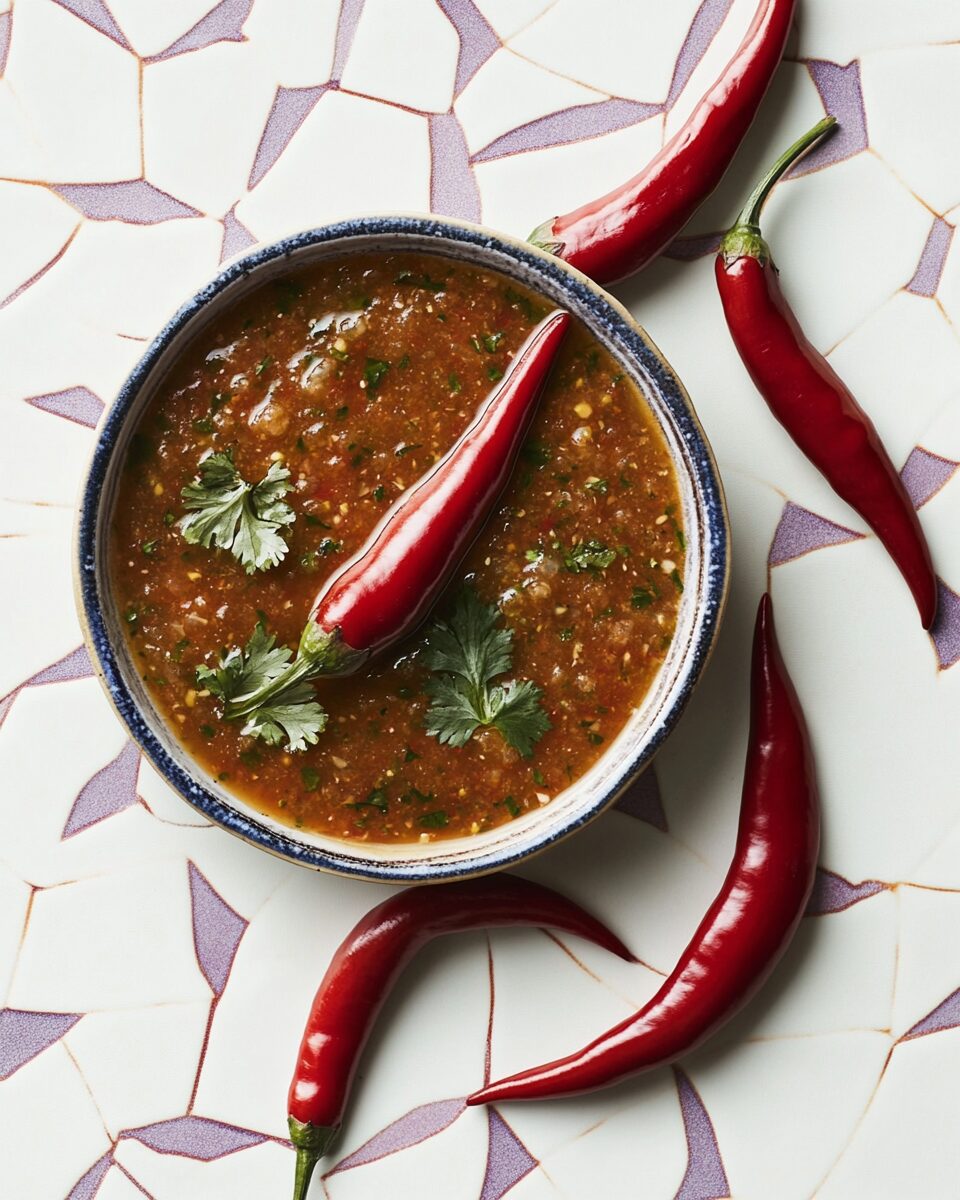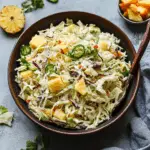Traditional salsa is a classic and vibrant condiment made with fresh ingredients. It combines tomatoes, onions, cilantro, and a bit of spice to create a flavorful dip perfect for any occasion. Easy to make, this salsa is a must-have for tacos, chips, or as a side to many Mexican dishes.
FULL RECIPE
Ingredients
- 4 medium tomatoes, diced
- 1 small onion, finely chopped
- 1-2 jalapeño peppers, seeds removed and finely chopped
- 1/4 cup fresh cilantro, chopped
- 2 tablespoons lime juice
- Salt and pepper, to taste
Directions
- In a medium bowl, combine the diced tomatoes, chopped onion, and jalapeños.
- Add the chopped cilantro and mix everything together.
- Stir in the lime juice, and season with salt and pepper to taste.
- Let the salsa sit for 10-15 minutes to allow the flavors to meld together before serving.
Nutritional Information
- Serving size: 1/4 cup
- Calories: 20
- Fat: 0g
- Carbohydrates: 4g
- Fiber: 1g
- Sugars: 3g
- Protein: 1g
Cultural Significance of Traditional Salsa
Traditional salsa is deeply rooted in Mexican culture, serving as more than just a condiment. It embodies the rich history and diverse culinary practices of Mexico, reflecting a blend of indigenous and Spanish influences. Salsa is integral to many Mexican dishes, enhancing flavors and adding a distinctive zest that is both cherished and celebrated across generations.
Regional Variations Across Mexico
Mexico’s vast geography has led to a plethora of regional salsa variations. In the Yucatán Peninsula, salsas often incorporate habanero peppers, providing intense heat. Central Mexico favors tomatillo-based green salsas, offering a tangy flavor. Northern regions might include dried chilies like chile de árbol, imparting a smoky depth. These regional differences highlight the adaptability and diversity of traditional salsa.
Health Benefits of Salsa Ingredients
Traditional salsa is not only flavorful but also nutritious. Tomatoes and tomatillos are rich in vitamins C and K, as well as antioxidants like lycopene. Chilies contain capsaicin, known for its metabolism-boosting properties. Onions and garlic offer anti-inflammatory benefits, while cilantro provides essential vitamins and minerals. Together, these ingredients make salsa a healthful addition to meals.
Pairing Salsa with Various Dishes
Salsa’s versatility allows it to complement a wide array of dishes. It enhances the flavors of tacos, burritos, and enchiladas. Grilled meats and seafood benefit from its zesty kick. Salsa can also be used as a topping for eggs, a mix-in for soups, or even as a marinade base. Its adaptability makes it a staple in many culinary applications.
Storage and Shelf Life
Proper storage ensures salsa maintains its freshness. Homemade salsa should be stored in an airtight container in the refrigerator and consumed within 3 to 5 days. For longer preservation, cooking the salsa before storing can extend its shelf life. Freezing is also an option, though it may alter the texture slightly.
Adjusting Heat Levels
The spiciness of salsa can be tailored to individual preferences. Removing seeds and membranes from chilies reduces heat. For a milder salsa, using fewer chilies or opting for varieties with lower Scoville ratings is effective. Conversely, adding more chilies or incorporating hotter varieties increases the spiciness. Balancing heat with acidity and sweetness ensures a harmonious flavor profile.
Incorporating Fruits for a Sweet Twist
Adding fruits introduces a delightful sweetness to traditional salsa. Mango, pineapple, and peach are popular choices, offering a contrast to the heat of chilies. These fruit-infused salsas pair well with grilled meats and seafood, providing a refreshing complement. The natural sugars in fruits also help balance the spiciness.
Utilizing Roasting Techniques
Roasting ingredients like tomatoes, chilies, and garlic enhances the depth of flavor in salsa. This process caramelizes natural sugars, imparting a smoky richness. Roasted salsas often have a more complex taste, making them a favorite for those seeking a robust flavor profile. Grilling or broiling are common methods used to achieve this effect.
Exploring Texture Variations
The texture of salsa can range from chunky to smooth, depending on preparation methods. Finely chopping ingredients results in a pico de gallo-style salsa. Blending creates a smoother consistency, ideal for dipping. Some prefer a hybrid texture, combining both chopped and blended elements for a unique mouthfeel.
Incorporating Nuts and Seeds
Adding nuts or seeds introduces a nutty flavor and creamy texture to salsa. Ingredients like roasted peanuts or pumpkin seeds can be blended into the salsa, offering a rich, earthy taste. This variation is particularly popular in certain regional Mexican cuisines, adding another layer of complexity.
Balancing Acidity and Sweetness
Achieving the right balance between acidity and sweetness is crucial in salsa preparation. Lime juice or vinegar provides the necessary acidity to brighten flavors. A touch of sugar or sweet fruits can counterbalance the heat and acidity, resulting in a well-rounded taste. Tasting and adjusting these elements ensures a harmonious flavor profile.
Using Salsa as a Marinade
Salsa can double as a flavorful marinade for meats and vegetables. Its acidic components help tenderize proteins, while the spices infuse them with robust flavors. Marinating for several hours or overnight yields the best results, enhancing the overall taste of the dish.
Incorporating Salsa into Soups and Stews
Adding salsa to soups and stews introduces depth and complexity. It serves as a flavor base, enriching the broth with its blend of spices and acidity. This technique is common in Mexican cuisine, where salsa forms the foundation of many traditional soups.
Creating Salsa-Based Sauces
Salsa can be transformed into various sauces by adjusting its consistency and incorporating additional ingredients. Cooking salsa with broth or cream creates a smoother sauce suitable for drizzling over dishes. This adaptability allows for creative culinary applications beyond traditional uses.
Pairing Salsa with Beverages
Salsa’s bold flavors pair well with a range of beverages. Traditional Mexican drinks like horchata or tamarind agua fresca offer a sweet contrast. For alcoholic options, margaritas or light beers complement the spiciness, enhancing the dining experience.
Serving Salsa at Different Temperatures
Salsa can be served at various temperatures, each offering a distinct experience. Chilled salsa provides a refreshing contrast to hot dishes. Warm salsa, especially when freshly prepared, offers a comforting accompaniment. Choosing the serving temperature depends on the intended dish and desired effect.
Sourcing Fresh, Quality Ingredients
The quality of ingredients greatly affects the flavor of the final salsa. Fresh, ripe tomatoes and vibrant herbs ensure the best results. Opting for organic produce can enhance the taste and nutritional value. Visiting local farmers markets is an excellent way to source high-quality, seasonal ingredients.
The Role of Traditional Tools
Traditional tools like the molcajete (a stone mortar and pestle) play a significant role in salsa preparation. Crushing ingredients by hand releases essential oils and creates a rustic texture. This method connects the cook to centuries-old culinary traditions, offering an authentic salsa-making experience.
Modern Twists on a Classic Recipe
Contemporary chefs often experiment with traditional salsa by incorporating unconventional ingredients. Avocado, roasted corn, or exotic chilies like ghost peppers introduce new dimensions. These modern twists respect the original concept while catering to evolving palates and culinary trends.
Salsa as a Cultural Bridge
Beyond its culinary appeal, traditional salsa acts as a cultural bridge, introducing people worldwide to Mexican flavors and traditions. It is a symbol of hospitality, often shared at family gatherings and celebrations. Making salsa at home fosters a deeper appreciation for the culture it represents.
Conclusion
Traditional salsa is a culinary gem that transcends its role as a simple condiment. Its rich history, regional diversity, and limitless variations make it a dynamic part of the global food landscape. Whether you’re savoring a classic tomato blend or experimenting with fruit-infused versions, salsa remains a celebration of flavor, tradition, and creativity. By exploring its nuances, we not only enjoy a delicious dish but also connect with a vibrant cultural heritage.






